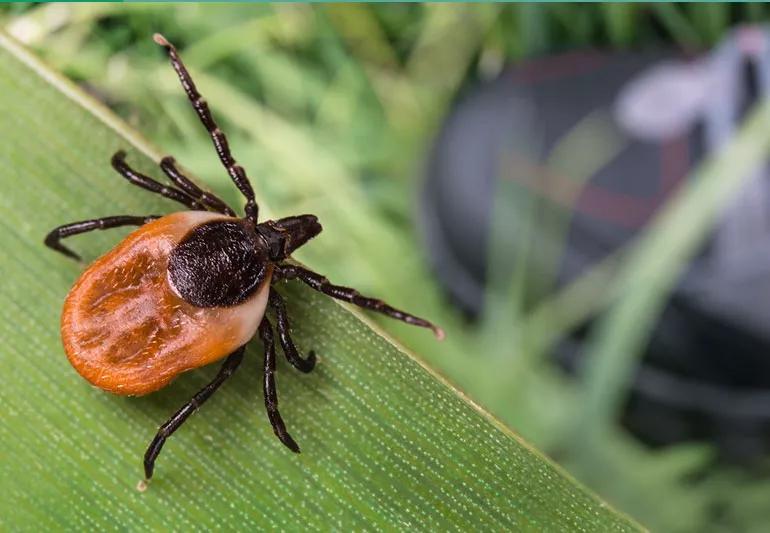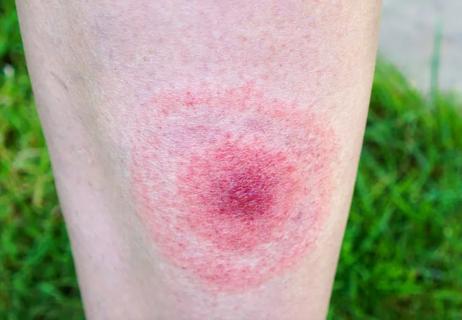Tips and tricks to prevent Lyme disease

Headed outside to soak up the sun and enjoy the outdoors? While the health and wellness benefits of being in nature are numerous, a walk on the wild side can, unfortunately, put you at risk for tick-borne diseases such as Lyme disease.
Advertisement
Cleveland Clinic is a non-profit academic medical center. Advertising on our site helps support our mission. We do not endorse non-Cleveland Clinic products or services. Policy
This risk is highest during warmer weather, when ticks are most active, according to the Centers for Disease Control and Prevention (CDC). So, what can you do to keep those buggers at bay and avoid their bites?
To explain the biggest risk factors in attracting ticks and getting Lyme disease, we spoke with emergency physician Christopher Bazzoli, MD, FAWM, DiMM.
Ticks are small arachnids (insects with eight legs, like spiders). They can be hard to spot because they’re small and favor making their home in grassy, overgrown and wooded areas. They’re also known to spread potentially dangerous diseases, like Lyme disease, via their bites.
That they can be so small and so hard to spot is part of the danger.
“It typically takes more than 24 hours for a tick to infect a human,” says Dr. Bazzoli. “If a tick falls into your hair or makes its way to a spot that’s hard for you to see even on your own body, like your armpit or groin, they could attach themselves and be there long enough to infect you.”
We often think of ticks as an issue that occurs in predominantly wooded areas, where ticks can fall from various leaves or other plants. But Dr. Bazzoli points out it’s always possible to pick up a tick, regardless of geography or landscape.
Advertisement
“You can sometimes find ticks even in your yard,” he says. “A well-cut lawn is less likely to house ticks, but it is still possible. While they are far more likely to be in the woods or in an overgrown area or yard, you have to be on guard during the warmer months of the year.”
It’s also important to remember that your pets and animals can bring ticks home to you from an overgrown or wooded area that they went and explored, says Dr. Bazzoli.
While you can pick up Lyme disease from a tick bite anywhere in the country, there are certain places in the United States where it’s more common for ticks to carry particular diseases. The regions most affected by ticks carrying Lyme disease are the Northeast, Mid-Atlantic and upper Midwest.
That doesn’t mean you can’t get Lyme disease from a tick outside those parts of the country, it’s just less common. “If you live in Nebraska, for instance, Lyme disease cases are far less common than in Pennsylvania or Connecticut,” notes Dr. Bazzoli.
While there are several diseases that ticks can spread, Dr. Bazzoli outlines these particular tick-borne diseases to be aware of, plus their symptoms.
There are several ways to protect yourself against ticks, tick bites and Lyme disease, according to Dr. Bazzoli. The best move? Take steps to prevent tick bites in the first place. Here’s how.
Wearing long pants and long-sleeve shirts may not feel the most comfortable for a warm-weather hike, but it’s the best way to keep ticks from getting on you at all. “Try to wear light colors since ticks can be small and are more easily spotted against brighter colors,” recommends Dr. Bazzoli.
He also suggests tucking your pant legs into your socks or shoes. “By tucking in those pants legs, you cut down on the chances of a tick being picked up from grass or lower bushes and crawling up your legs.”
Dr. Bazzoli has two recommendations when it comes to bug sprays to prevent ticks.
Advertisement
“Between the permethrin, DEET or picaridin sprays, and the protective clothing,” says Dr. Bazzoli, “you should have a very low risk of acquiring ticks and tick-borne diseases.”
When you’re out hiking, try to stick to lightly wooded areas and avoid areas with high grass. If there are trails available, stick to them as much as possible and try to walk down the center.
As careful as you might be in preventing ticks, sometimes, they still sneak through your defenses and attach themselves to your skin. That’s why a full-body search every night after spending time outdoors — maybe even with the help of a partner — is so important after outdoor excursions where you’re more at risk for ticks.
“The real key is to catch them early, well before that 24-hour mark where a disease is more likely to be transmitted,” says Dr. Bazzoli.
If you find a tick attached to you, it’s possible to remove it. You just want to be careful.
First, gently clean the area around the tick with rubbing alcohol on a cotton swab. Then, using fine-nosed tweezers, get as close as possible to the point at which the tick’s head is attached to your skin and gently — but firmly — remove the tick.
Just don’t squeeze the body of the tick, says Dr. Bazzoli: “If you squeeze the body of the tick, it can cause the tick to regurgitate bacteria into your body via the bite.”
Advertisement
As for the old-school approach of trying to burn a tick off with a match or lit cigarette? Dr. Bazzoli says that’s just not a good idea (for what should be obvious reasons).
And, of course, you can always consult your healthcare provider, especially if you’re not sure when you might have picked up the tick. If you’ve caught it within a day, chances are you’re in the clear. But if it’s been longer, your doctor might recommend a dose of antibiotics to prevent infection.
If you remove the tick yourself, be sure to gently clean the area of the bite with warm water and soap. After drying the area, swab it with alcohol or apply an over-the-counter antibiotic ointment and then, cover it with a bandage. This helps protect against infection.
But it’s also important to check in with your healthcare provider. There’s always a chance you didn’t properly remove the tick and part of it remains lodged in your skin.
In some circumstances, particularly in parts of the country where Lyme disease is more prevalent, Dr. Bazzoli says some healthcare providers will prescribe antibiotics even if there aren’t symptoms of Lyme disease.
“If you take an antibiotic within 72 hours of the bite, you can prevent Lyme disease,” says Dr. Bazzoli. “So, there is a prophylactic approach in very high incident areas.”
Advertisement
If you start showing the initial symptoms of Lyme disease, get treated as soon as possible. Lyme disease could result in more serious and sometimes permanent health issues.
“Left untreated, Lyme disease can cause arthritis, usually in only one or two joints,” says Dr. Bazzoli, noting the knee joint is most common. “It can also cause Bell’s palsy, nerve inflammation and even meningitis.”
Even if you find a tick and successfully remove it within a day or so, he says it’s not a bad idea to follow up with your healthcare provider. That’s especially important if you live in, or have visited, an area where Lyme disease is more common.
Learn more about our editorial process.
Advertisement

After infection clears, full recovery can take time

Most recommended precautions center around minimizing bruising or swelling

Even one drink can have an impact on your cognitive function leading to slurred speech, blurred vision and impaired memory

Understand who may (and may not) benefit

Lorem ipsum dolor sit amet. Et odio Quis vel ipsam omnis eum alias deleniti et placeat impedit non voluptas galisum hic autem enim et cupiditate aliquid. Est beatae quidem non facilis autem ut commodi nisi aut tempore rerum et dolores voluptatem cum enim optio id sapiente quasi. Ad laboriosam officiis 33 cupiditate sequi ea voluptatum consectetur qui necessitatibus voluptate et quasi doloremque et facere explicabo quo explicabo officia

Seeking help through therapy can be an important step in improving your quality of life when you have UC

Type 2 diabetes isn’t inevitable with these dietary changes

Applying a hot or cold compress can help with pain